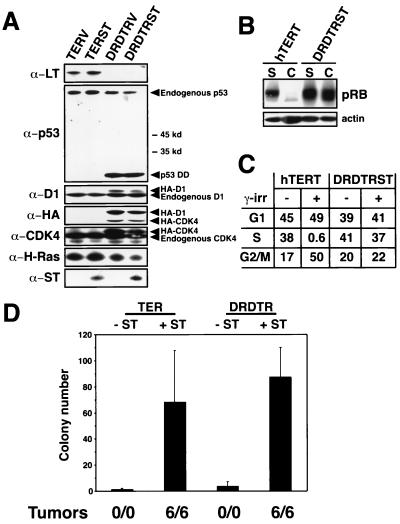FIG. 5.
Perturbation of the pRB and p53 tumor suppressor pathways. (A) Expression of indicated proteins in BJ cells expressing LT, hTERT, and ras with (TERST) or without (TERV) ST or in BJ cells expressing a combination of cyclin D1 (D1), the R24C CDK4 mutant form, hTERT, and ras with (DRDTRST) or without (DRDTRV) ST. One hundred micrograms of total cell protein was separated on 7.5 to 15% gradient gels, transferred nitrocellulose, and sequentially immunoblotted. The p53DD mutant form is a truncated form of p53, stabilizes endogenous p53, and migrates at approximately 28 kDa (70). Relative molecular mass (kilodaltons [kd]) is indicated. The D1 and R24C CDK4 proteins are HA epitope tagged and migrate more slowly than the endogenous forms of these proteins. Both the HA-tagged and endogenous forms of these proteins are indicated by arrowheads. All of the cell lines express hTERT, as assessed by TRAP assay (data not shown). (B) Effects of cyclin D1 and R24C CDK4 expression on pRB phosphorylation. Immunoblotting demonstrating pRB phosphorylation of cells growing exponentially (subconfluent [S]) or at confluence (C). BJ cells expressing only hTERT (hTERT) were used as a control. (C) Effects of gamma irradiation (γ-irr). Parallel cultures of BJ fibroblasts expressing only hTERT (hTERT) or DRDTRST were treated with 5 Gy. The percentage of cells in each phase of the cell cycle was determined by BrdU incorporation and propidium iodide staining 24 h after irradiation. (D) AI growth and tumorigenicity of the indicated cell lines. The mean and standard deviation of six experiments are shown. Tumor formation is reported as in Fig. 1.

